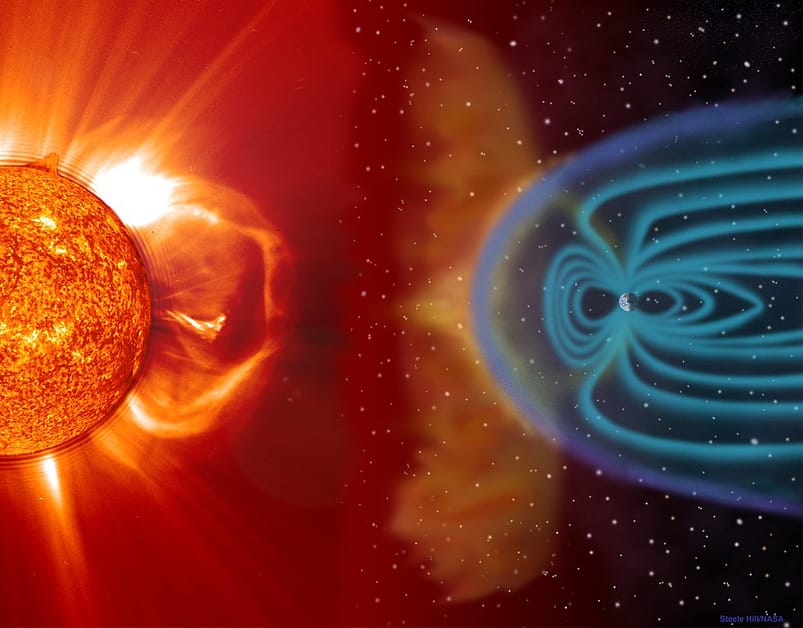
<a href="https://www.flickr.com/photos/24662369@N07/4445502419" rel="nofollow">NASA Sun Earth</a> by <a href="https://www.flickr.com/photos/24662369@N07" rel="nofollow">NASA Goddard Photo and Video</a> is licensed under <a href="https://creativecommons.org/licenses/by/2.0/" rel="nofollow">CC-BY 2.0</a>
The Basics of Earth’s Magnetic Field and Pole Shift
Earth’s magnetic field is a vital component of our planet’s ecosystem, generated by the movement of molten iron in the outer core, which creates electric currents. These electric currents produce a magnetic field that extends beyond the surface of the Earth, forming a protective shield known as the magnetosphere. This magnetosphere plays a crucial role in safeguarding the planet from solar radiation and cosmic rays, which can pose serious threats to life and technology. A magnetosphere is a region of space surrounding a celestial body with a magnetic field, affecting charged particles from the object’s interior dynamo. The Earth’s magnetosphere is capable of blocking or mitigating the effects of solar and cosmic radiation. The study of Earth’s magnetosphere began in 1600, and significant discoveries were made in the 20th century, including the existence of the Van Allen radiation belt and the magnetopause.
Key discoveries and milestones:
1983: International Cometary Explorer observes the magnetotail.
1600: William Gilbert discovers Earth’s magnetic field resembles a magnetized sphere.
1940s: Walter M. Elsasser proposes dynamo theory, attributing Earth’s magnetic field to iron outer core motion.
1958: Explorer 1 observes the Van Allen radiation belt.
1959: Thomas Gold proposes the term “magnetosphere” to explain solar wind interaction with Earth’s magnetic field.
1961: Explorer 12 observes the magnetotail.
1963: Cahill and Amazeen observe a sudden decrease in magnetic field strength near the noon-time meridian.
The phenomenon of magnetic pole shift refers to the gradual change in the orientation of Earth’s magnetic field. Over geological time scales, the magnetic poles have undergone multiple shifts, wherein the north magnetic pole can migrate to the south and vice versa. These shifts can occur over thousands of years, and though they may seem slow, they can significantly impact navigation systems and animal behaviors, especially for species that rely on magnetoreception for migration.

The timing of magnetic pole shifts varies; historically, these events have occurred approximately every 200,000 to 300,000 years. However, the intervals are not consistent, and some researchers suggest the magnetic field has weakened in recent centuries, prompting discussions about a potential impending shift. Furthermore, the precession of the equinox, the gradual wobble in the Earth’s rotation axis, is significant in understanding magnetic fluctuations. This phenomenon alters the position of the equinoxes over time and affects various natural systems, including climate and seasonal cycles.
Understanding the dynamics of Earth’s magnetic field and the implications of a magnetic pole shift is essential. A significant weakening or even a complete disappearance of the magnetic field could expose the planet to enhanced radiation levels and disrupt technological systems reliant on magnetic stability. Such scenarios underline the importance of further research into the mechanisms behind magnetic shifts and their potential global impacts spanning from ecological to climatological disruptions.

Impacts on Wildlife and Global Systems
The Earth’s magnetic field plays a crucial role in the survival and navigation of various wildlife species. Many migratory birds, for instance, rely on the magnetic field as a natural compass to guide them on their long journeys. These birds utilize magnetoreception—a biological ability to perceive magnetic fields—to navigate accurately during seasonal migrations. If a magnetic pole shift occurs, the consequences for these birds could be dire, leading to confusion and potential disruptions in migration patterns. This could further result in adverse effects on breeding, food availability, and overall population dynamics.
In addition to avian species, bees also utilize the Earth’s magnetic field for navigation while foraging and returning to their hives. A disturbance in the magnetic field may impact their ability to locate flowers or return to their nesting sites, potentially threatening pollination processes that are vital for plant reproduction and, subsequently, food production systems globally. This interplay between wildlife and the magnetic field highlights the interconnectedness of ecosystems and the potential cascading effects that a shift could trigger.
Marine life, particularly migratory fish species, also depend on geomagnetic cues to navigate through vast ocean expanses. A significant alteration in the magnetic field might lead to disorientation in these species, impacting their reproduction and feeding grounds. Such disturbances could result in broader implications for marine ecosystems and the fishing industries dependent on these vital species.
Beyond wildlife, human systems such as transportation are also susceptible to the effects of magnetic pole shifts. Aviation and shipping industries rely heavily on precise navigational tools that utilize magnetic data. A shift or weakening of the magnetic field could necessitate continual adjustments to navigational instruments, leading to increased operational challenges and safety concerns. Thus, understanding the intricate relationship between Earth’s magnetic field and various life forms highlights the importance of ongoing research into the potential impacts of magnetic pole shifts on wildlife and global systems.
Historical Context and Geological Evidence
The Earth has experienced numerous magnetic pole shifts throughout its geological history, phenomena known as geomagnetic reversals. These significant events occur when the planet’s magnetic field temporarily weakens and eventually reverses, resulting in the north and south poles switching places. Geological studies suggest that on average, these reversals happen every 200,000 to 300,000 years, although the frequency can vary. For instance, the last major reversal, the Brunhes-Matuyama transition, occurred approximately 780,000 years ago. Analyzing ancient lava flows has proven essential in documenting these phenomena, as the orientation of iron-rich minerals within the rock solidifies in alignment with the Earth’s magnetic field at the time of their eruption. Such evidence provides a chronological record of past magnetic field orientations.
Notably, the effects of these reversals extend beyond mere magnetic realignment. Stratigraphic records indicate that past geomagnetic reversals may have influenced climate patterns, such as the distribution of certain species and vegetation during transitional periods. Furthermore, disruptions in cosmic ray exposure—linked to a weakened magnetic field—could result in increased levels of radiation reaching the Earth’s surface, potentially affecting both flora and fauna.
Future Predictions and Scientific Investigations
Scientific research on magnetic pole shifts has gained attention as our understanding of Earth’s magnetic field continues to evolve. Current studies utilize advanced satellite technology and geophysical models to track fluctuations in the magnetic field, which is pivotal in predicting potential pole shifts. These shifts could have profound implications for navigation systems, wildlife migrations, and even technological infrastructures. A notable concern among scientists is the increased occurrence of solar flares, which may exacerbate the effects of magnetic shifts on satellite operations and communication systems. Observations have indicated that as the magnetic field weakens, the planet becomes more susceptible to the impacts of solar winds, leading to heightened radiation exposure on Earth.
Future predictions related to the magnetic field suggest that a complete magnetic pole reversal is plausible within the next few thousand years. While these shifts occur on geological timescales, experts emphasize the need for ongoing research to monitor changes in the magnetic field’s intensity and configuration. Understanding the dynamics of this phenomenon is essential as it can affect both the biosphere and human technological activities. Moreover, investigating these occurrences provides insight into the geological processes that govern the Earth’s core.
While some researchers speculate that magnetic field shifts might play a role in climatic changes, definitive conclusions remain elusive. Thus, as scientific investigations continue, a balanced approach is necessary, recognizing both the significance of Earth’s magnetic shifts and the complexity of climate system interactions.
Sources:
https://www.ncei.noaa.gov/news/tracking-changes-earth-magnetic-poles
https://en.wikipedia.org/wiki/Magnetosphere
Helpful links:
https://www.ncei.noaa.gov/maps/historical-declination (wandering pole animation).
Discover more from EAGLE HORIZON REPORT
Subscribe to get the latest posts sent to your email.



